Fascinating Facts About Chinchillas You Never Knew
You'll be amazed by these lesser-known chinchilla facts. These Andean natives boast the densest fur of any land mammal, with up to 75 hairs per follicle. They're nocturnal, sleeping 12-14 hours daily, and communicate through barks, whistles, and grunts. Chinchillas practice caecotrophy, consuming specific droppings to maximize nutrient absorption. Their teeth grow continuously, necessitating constant chewing. Dust bathing is essential for fur health, while water baths can be harmful. With a lifespan of up to 20 years, chinchillas form complex social structures in groups of up to 100 individuals. Sadly, they're endangered due to over-hunting and habitat loss. There's much more to uncover about these fascinating creatures.
This post may contain affiliate links. If you make a purchase through these links, I may earn a commission at no additional cost to you. Additionally, portions of this post may be generated using artificial intelligence (AI) technology. While we strive for accuracy, please be aware that AI-generated content may not always be perfect and should be fact-checked when necessary.
The Spatula Scoops
- Chinchillas have the densest fur of any land mammal, with up to 75 hairs growing from each follicle.
- They practice "fur slipping," a unique defense mechanism allowing them to escape predators by shedding patches of fur.
- Chinchillas engage in caecotrophy, consuming specific droppings to maximize nutrient absorption and maintain gut health.
- They can survive temperatures as low as 23°F (-5°C) in their native Andean mountain habitats.
- Chinchillas require dust baths, not water, to maintain their fur's health and cleanliness.
Chinchilla Origins and Habitat
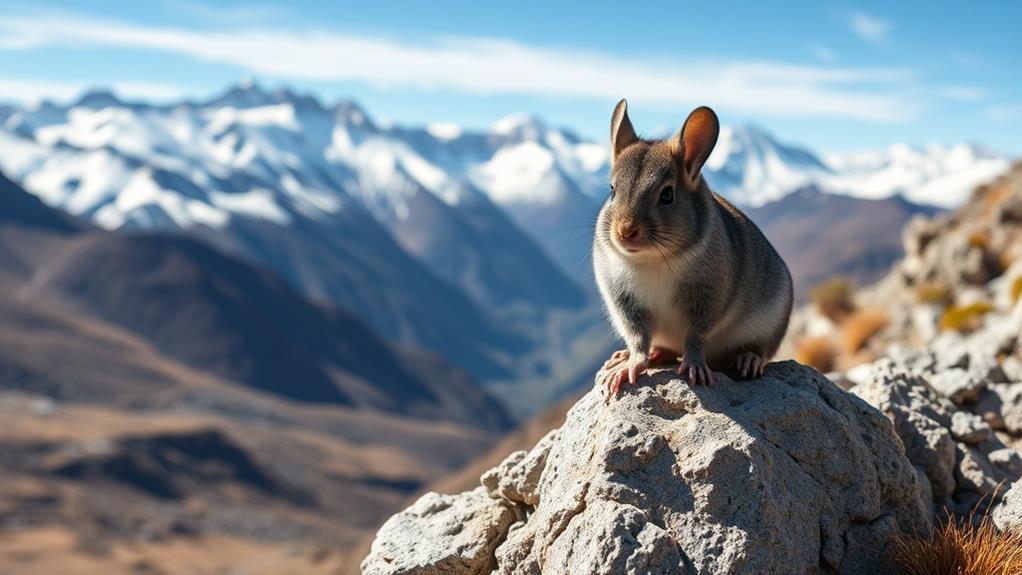
Nestled high up in the Andes mountains of South America, chinchillas have adapted to thrive in harsh, rocky environments. You'll find these resilient creatures at elevations between 9,800 and 16,400 feet, where temperatures can plummet to a chilly 23°F (-5°C). Their habitat consists of rocky outcrops and arid landscapes, essential for their survival.
Chinchillas' dense fur plays an important role in their adaptation to this unforgiving terrain. With 50-75 hairs per follicle, their coats provide excellent insulation against the cold and help regulate body temperature. This remarkable fur, however, has led to their endangerment due to over-hunting.
In their native habitat, chinchillas have developed unique ways to survive. They primarily feed on plants, grasses, and leaves found in their environment. To quench their thirst in this dry climate, they've adapted to use morning dew and moisture from cacti as water sources.
Unfortunately, historical over-hunting has severely impacted chinchilla populations and their habitat. As a result, these fascinating creatures are now classified as endangered, highlighting the significance of conservation efforts to protect their natural environment in the Andes.
Unique Fur Characteristics
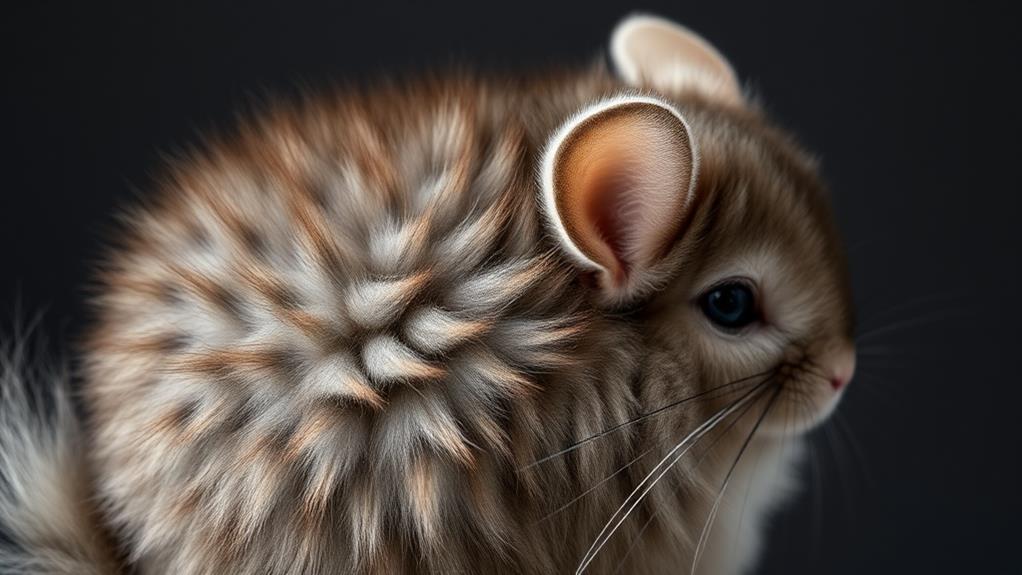
A marvel of nature, chinchilla fur stands out as the densest among all land mammals. You'll be amazed to learn that each hair follicle in a chinchilla's fur coat houses 50-75 individual hairs, far surpassing the mere 2-3 hairs found in human follicles. This thick fur serves an essential purpose, insulating these creatures against the frigid temperatures of their native Andes mountains, where the mercury can plummet to 23°F.
The coloration of chinchilla fur typically ranges from grey to white, blue, and black. Their signature grey hue provides natural camouflage in rocky terrain. Curiously, chinchillas have developed a unique defense mechanism called "fur slipping." When threatened, they can shed patches of fur, facilitating a quick escape from predators.
While their dense coats offer excellent protection against cold, they can be a liability in warm climates. Chinchillas are susceptible to overheating, requiring living conditions below 75°F. To maintain their luxurious fur, these animals take dust baths, which help remove excess oils and keep their coats clean and healthy.
Dust Bathing Behavior
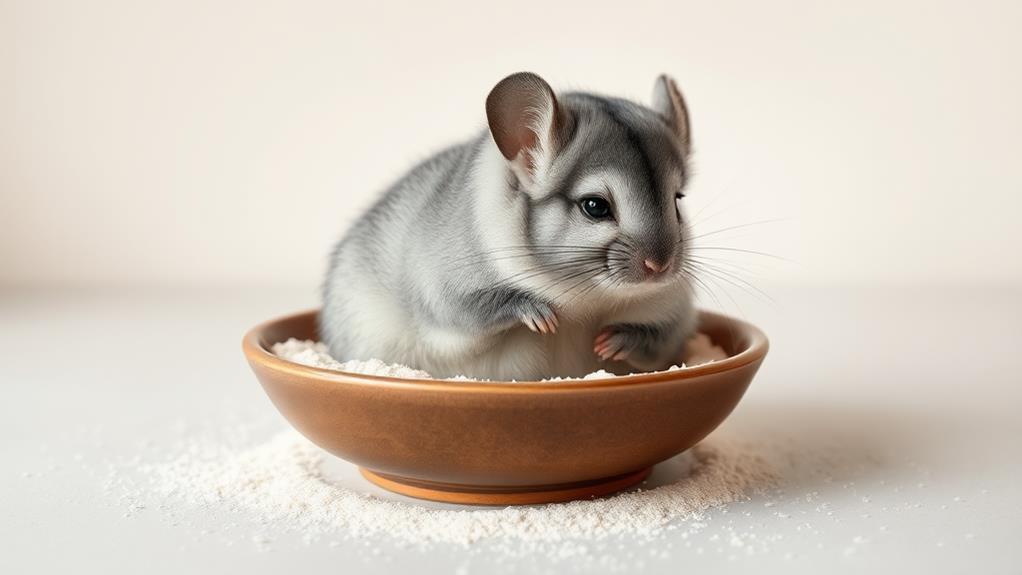
When it comes to dust bathing, your chinchilla has some essential needs that you'll want to meet. You'll need to provide a suitable container filled with the right type of dust, such as volcanic ash, which is vital for maintaining your pet's dense, soft fur. Regular dust baths, typically 2-3 times a week, offer numerous benefits for your chinchilla, including cleansing their coat, removing excess oils, and promoting overall fur health.
Dust Bath Essentials
For chinchillas, dust bathing isn't just a luxury—it's a necessity. These adorable creatures require frequent dust baths to keep their dense fur clean and healthy. Chinchillas typically need 2-3 dust baths per week, each lasting about 10-15 minutes. During these sessions, they roll and burrow in the dust, allowing their fur to escape excess oils and moisture.
To provide the perfect dust bath for your chinchilla, you'll need a few essentials:
| Item | Size | Frequency |
|---|---|---|
| Container | 6 x 6 x 12 inches | Replace every 2-3 weeks |
| Volcanic ash dust | 1-2 inches deep | Refill as needed |
| Bathing time | 10-15 minutes | 2-3 times per week |
It's vital to use volcanic ash dust, as its fine texture is ideal for penetrating the chinchilla's dense coat. Water baths are a big no-no for these furry friends, as they can lead to fur loss and increase the risk of fungal infections. By providing regular dust baths with the right setup, you'll guarantee your chinchilla's fur remains soft, clean, and healthy.
Benefits of Bathing
Dust bathing offers numerous benefits for chinchillas beyond just keeping their fur clean. These adorable creatures need to take dust baths two to three times per week to maintain their health and well-being. When you provide your chinchilla with a proper dust bath setup, you're helping them prevent a range of potential health issues.
The fine volcanic ash dust used in these baths helps keep your chinchilla's fur soft, clean, and free from excess oils and moisture. This is vital because water baths can be detrimental to their dense coat, leading to fungal growth and even hypothermia. During a dust bath, you'll notice your chinchilla rolling, jumping, and digging through the dust for about 10-15 minutes. This behavior isn't just fun for them; it's a natural instinct that stimulates their skin and promotes a healthy coat.
Regular dust bathing also contributes to your chinchilla's overall physical and social well-being. It allows them to express their natural behaviors and maintains their mental health. By providing this essential grooming opportunity, you're ensuring your chinchilla stays happy, healthy, and looking their best.
Dietary Needs and Habits
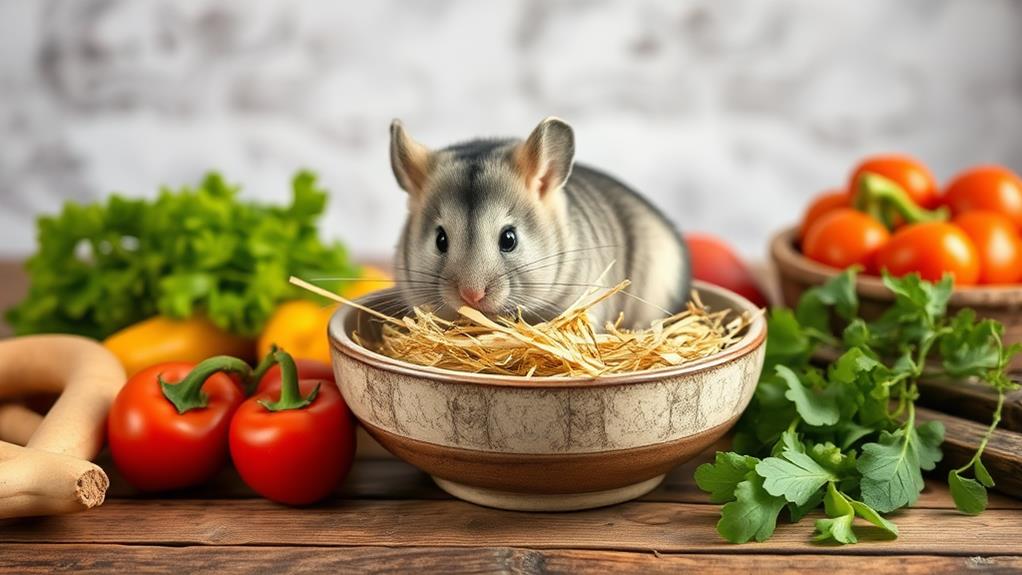
You'll find that chinchillas have unique dietary needs centered around a high-fiber diet, with Timothy hay being the cornerstone for adults. Their teeth grow continuously throughout their lives, necessitating constant chewing to maintain proper dental health. Chinchillas also practice caecotrophy, a process where they consume their own droppings to maximize nutrient absorption, which is vital for their digestive health.
High-Fiber Diet Essentials
What's the key to keeping your chinchilla healthy? It's all about providing a high-fiber diet tailored to their herbivorous nature. Your fluffy friend's diet should primarily consist of Timothy hay, which is essential for their digestive health and helps prevent obesity. You'll want to make this hay available at all times, as it forms the backbone of their nutritional needs.
While hay is important, you shouldn't forget about other dietary components. Offer your chinchilla 1-2 tablespoons of pelleted food daily, complemented by small servings of low-calcium vegetables and fruits. This balanced approach guarantees they receive all necessary nutrients. Remember, chinchillas are adapted to extract moisture from their food in the wild, so fresh water must always be accessible in their habitat.
Monitoring your chinchilla's food intake is significant. Their dense fur can make it challenging to visually assess their body condition, so you'll need to be vigilant about portion control. By maintaining a proper diet, you're not just feeding your pet; you're supporting their overall health and longevity.
Continuous Tooth Growth
Like many rodents, chinchillas have open-rooted teeth that grow continuously throughout their lives. This unique characteristic means their teeth never stop growing, with an average growth rate of 2-3 inches per year. If you're a chinchilla owner, you'll need to pay close attention to your pet's dental health to prevent potential problems.
To maintain healthy teeth, chinchillas require a high-fiber diet, primarily consisting of hay like Timothy hay. This diet promotes natural wear on their teeth through constant chewing. You can also provide chew toys and treats to offer additional chewing opportunities, helping to keep their teeth at a manageable length.
It's essential to monitor your chinchilla's teeth regularly for signs of overgrowth. If you notice your pet drooling or having difficulty eating, it may indicate dental issues. Left unchecked, overgrown teeth can lead to serious dental problems, affecting your chinchilla's overall health and well-being.
Caecotrophy for Nutrient Absorption
Many people are surprised to learn that chinchillas practice caecotrophy, a unique dietary habit that involves consuming their own feces. But don't be grossed out—this process is vital for their health and survival.
When you see your chinchilla eating its own droppings, it's not being gross; it's actually maximizing nutrient absorption from its high-fiber diet. Chinchillas consume soft fecal pellets directly from their anus, which contain essential nutrients that weren't fully digested the first time around. This clever adaptation allows them to extract more nutrition from their food, helping them thrive in their native dry habitats.
To support this digestive process, you'll need to provide your chinchilla with a diet rich in high-fiber foods, especially Timothy hay. This keeps their intestines functioning at their best and promotes gut health. Don't forget to make certain your furry friend has constant access to fresh water, as proper hydration is critical for efficient digestion and nutrient absorption during caecotrophy.
Nocturnal Lifestyle and Activity
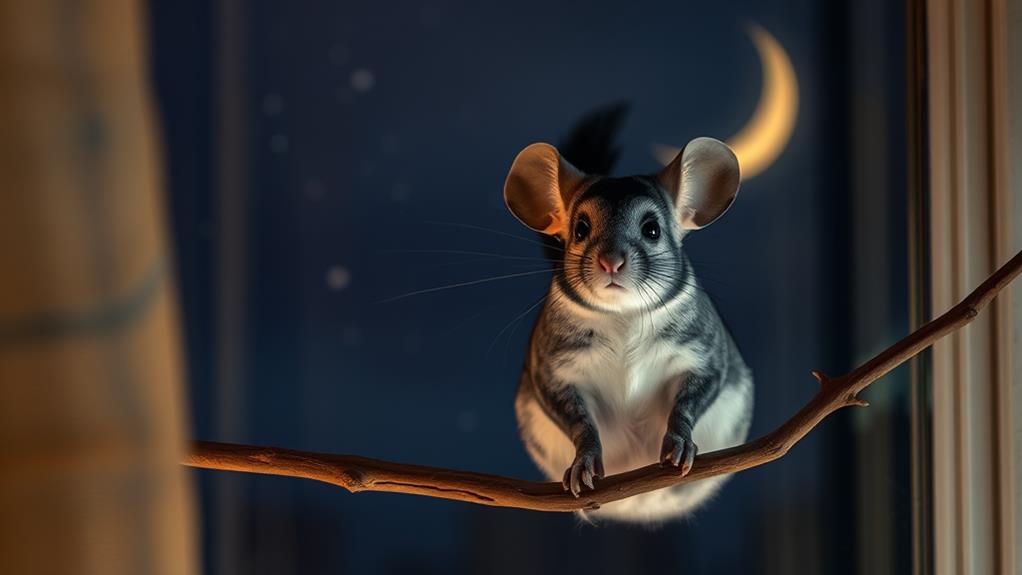
Adaptability defines the chinchilla's nocturnal lifestyle. These fascinating creatures have evolved to thrive in low-light conditions, with their large eyes and sensitive whiskers aiding navigation during their active periods. You'll find chinchillas most lively during dawn and dusk, when they engage in foraging and social interactions.
As social animals, chinchillas communicate and bond during their nighttime activities. Their nocturnal nature means they typically sleep for 12-14 hours during the day, conserving energy for their nighttime adventures. However, they can adjust their schedules based on their environment and companionship.
To keep your chinchilla healthy and happy, consider these tips:
- Provide a quiet, dark space for daytime sleeping
- Offer engaging activities during their active hours
- Respect their natural rhythm by avoiding disturbances during rest periods
While chinchillas are primarily nocturnal, they thrive with regular engagement and stimulation. You can support their natural behaviors by creating an environment that caters to their unique lifestyle. By understanding and accommodating their nocturnal tendencies, you'll guarantee your chinchilla remains healthy, active, and content in your care.
Reproduction and Lifespan
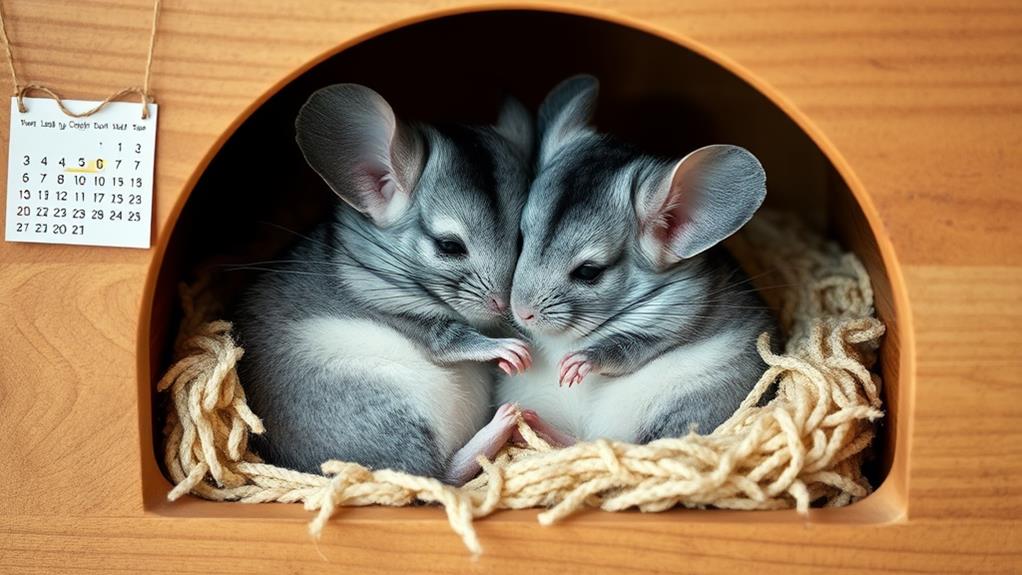
From birth to old age, chinchillas captivate with their unique reproductive traits and impressive lifespan. You'll be amazed to learn that baby chinchillas, called kits, are born fully furred with open eyes and ears after a gestation period of about 111 days. These adorable creatures typically arrive in pairs, as the average litter size is two, though it can range from one to six kits.
As chinchillas grow, they reach sexual maturity around eight months of age, allowing them to reproduce as they approach adulthood. This early maturity contributes to their ability to maintain stable populations in captivity.
When it comes to lifespan, chinchillas can live anywhere from 10 to 20 years with proper care. You'll need to reflect on factors like genetics, health care, and regular veterinary check-ups to guarantee your chinchilla reaches its full potential lifespan. As they age, it's vital to monitor for age-related issues and adjust their care accordingly.
Communication and Social Structure
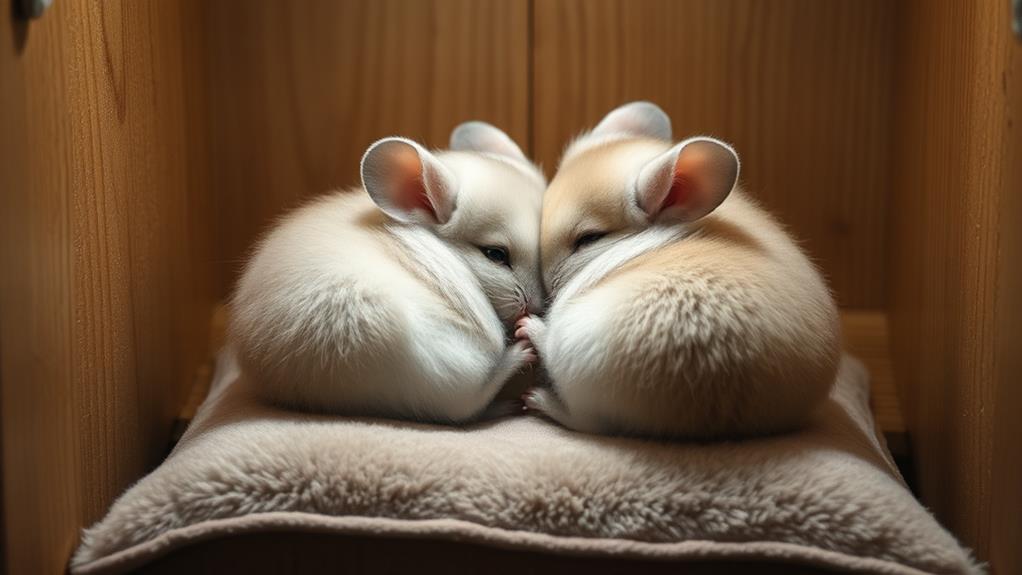
Despite their small size, chinchillas possess a complex social structure and communication system. These social creatures use various vocalizations, including barks, whistles, and grunts, to express emotions and interact with one another. In the wild, chinchillas live in large groups of up to 100 individuals, relying on these social structures for companionship and stress reduction.
Understanding chinchilla communication is vital for their care. You'll want to familiarize yourself with their vocal patterns and behaviors to guarantee a conducive environment. Here are three key aspects of chinchilla social dynamics:
- Female dominance: Females are often larger and more dominant within their communities.
- Hierarchies: Social order is established through behaviors like teeth chattering and urine spraying.
- Threat communication: Chinchillas use specific vocalizations and actions to protect their territory.
Dental Health and Care
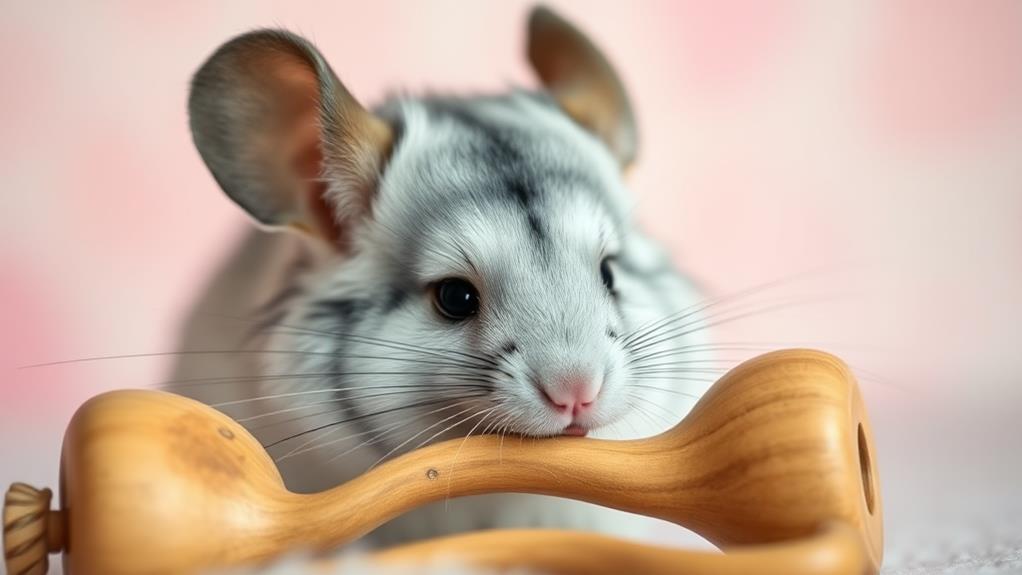
With their ever-growing teeth, chinchillas require special attention to dental health. These small rodents' teeth grow continuously, averaging 2-3 inches annually. To maintain proper tooth wear, you'll need to provide a high-fiber diet and chewing materials. Without these, your chinchilla may develop malocclusion, a painful condition where teeth misalign.
You'll want to monitor your chinchilla's dental health closely. Watch for signs of dental issues, such as drooling, difficulty eating, or weight loss. Regular veterinary visits are essential, especially for older chinchillas who are more susceptible to dental problems.
Here's a quick guide to maintaining your chinchilla's dental health:
| Diet | Chewing Materials | Monitoring |
|---|---|---|
| Fresh hay | Untreated wood | Regular check-ups |
| High-fiber pellets | Pumice stones | Watch for drooling |
| Limited treats | Chew toys | Observe eating habits |
Are There Any Similarities Between Hamsters and Chinchillas?
Hamsters and chinchillas share similarities in their playful nature and love for exploring their surroundings. Both are small, furry pets that thrive with proper care and attention. While uncovering hamster fun facts, you’ll notice their active behaviors align with a chinchilla’s need for exercise, making both fascinating companions for animal enthusiasts.
Conservation Status and Threats

While chinchillas' dental health requires careful attention, their very existence in the wild faces significant challenges. Chinchillas are called endangered due to over-hunting and habitat loss, pushing them near extinction. These adorable creatures, prized for their incredibly dense fur, have seen their populations plummet by more than 90% in the last century.
The threats to chinchillas are multifaceted:
- Over-hunting for their luxurious fur, which can have up to 60 hairs per follicle
- Habitat loss from agricultural expansion in their native Andes mountain range
- Ongoing illegal trapping and poaching, despite legal protections
Conservation efforts are underway to protect these vulnerable animals, but they face significant hurdles. While legal protections exist in many regions, awareness and compliance with hunting regulations remain vital for chinchilla population recovery. The harsh environments of the Andes mountains, where chinchillas are native, further complicate conservation efforts.
As you learn about these fascinating creatures, it's important to understand the critical state of their wild populations. Your awareness can contribute to their protection and help guarantee these unique animals don't disappear from their natural habitats.
Frequently Asked Questions
What Are 5 Interesting Facts About Chinchillas?
You'll be amazed to learn these five interesting facts about chinchillas:
- They have the densest fur of any land mammal, with up to 75 hairs per follicle.
- Chinchillas are nocturnal and can jump up to six feet high.
- Their babies, called kits, are born fully furred with open eyes.
- They require regular dust baths to keep their coats clean and healthy.
- Chinchillas are social creatures that thrive in the company of others, including their owners.
What Are the Special Abilities of a Chinchilla?
Did you know chinchillas can jump up to six feet high? That's just one of their special abilities. You'll find these rodents have dense fur, with up to 75 hairs per follicle, providing excellent insulation. They're equipped with powerful hearing and sensitive whiskers for maneuvering in the dark. Chinchillas can also shed patches of fur to escape predators, a unique defense mechanism called "fur slipping." Finally, their red blood cells can hold more oxygen, allowing them to thrive at high altitudes in the Andes mountains.
Why Can't Chinchillas Get Wet?
You shouldn't let your chinchilla get wet because their dense fur can trap moisture, leading to fungal infections and skin problems. Their coat is designed for dry environments, efficiently insulating them without needing water. Water baths are harmful, as they take too long to dry, risking hypothermia. Instead, you should provide dust baths 2-3 times weekly using fine volcanic ash or chinchilla dust. This method effectively cleans their fur, removes excess oil and dirt, and maintains their skin health.
Why Can't You Touch Chinchillas?
You can't touch chinchillas frequently because their dense fur is sensitive to oils and moisture from your hands. This can disrupt their fur's natural insulation and lead to skin issues. Chinchillas are shy creatures, and excessive touching can cause them stress. They may even experience "fur slipping" if they feel threatened. While gentle handling is important for bonding, you should acclimate them to human touch gradually to minimize anxiety and maintain their well-being.





